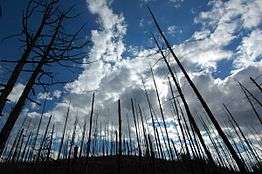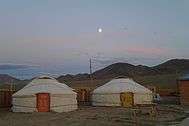Environmental issues in Mongolia
There are many pressing environmental issues in Mongolia that are detrimental to both human and biophysical wellness. These problems have arisen in part due to natural factors, but increasingly because of human actions. One of these issues is climate change, which will be responsible for an increase in desertification, natural disasters, and land degradation. Another is deforestation, which is expanding due to human recklessness, pests, disease, and fire. Mongolian lands are becoming more arid through desertification, a process that is being exacerbated due to irresponsible land use. Additionally, more and more species are disappearing and at risk for extinction. And, especially in population centers, Mongolians deal with air and water pollution caused by human industrialization.
Climate change
Climate change has threatened the ways of life for traditional pastoralist herders, as it is a driving factor of disruptive duds, also known as climatic events or natural disasters. Winter storms, drought periods, and extreme temperatures have become more frequent.[1] Leading up to 2000, there were approximately 20 extreme events per year, but since 2000, this number has doubled to 40 events per year. Between 2008 and 2010 Mongolia experienced 153 extreme events, most of which being strong winds, storms, and floods from run-off.[2]
Since 1940, the average yearly temperature in Mongolia has increased by at least 1.80C. This temperature shift is deemed responsible for an increase in grassland aridity, and as a result, a lowering of the production of biomass. The Gobi desert is expected to creep northward at approximately 6–7 km / year, which is expected to further limit pastureland.[1]
Another result of these meteorological shifts is expected to be precipitation that occurs in concentrated bursts and cannot be absorbed by the soil. The rising temperatures will also melt high mountain glaciers, degrade permafrost, and will cause more transpiration from plants.[1]

Deforestation
Mongolia has low forest resources, and due to its harsh climate, the growth of its forests is slow. Nevertheless, the forests help maintain water conditions, prevent soil deterioration, preserve permafrost, and control greenhouse gases and other harmful emissions. However, these limited forest resources have been diminishing due to logging, fires, pests, and disease.
By 2000, over 1.2 million ha of forested land had been invaded by pests. Due to the spread of pests, over 300,000 ha of forest was unable to grow.[3]
Fires saw increased regularity due to carelessness of people who entered the forest (such as through escaped campfires, military activities, agricultural machinery),[4] further deteriorating the forest cover.[3] In 2008, 178 forest fires occurred, affecting 927,990 hectares of steppe and causing a 17.6 billion loss in tugriks.
Trees were also cut for use as fuel, amounting to a yearly 1.3 million cubic meters of wood a year. Additionally, the timber industry's poor logging techniques and inefficiency led to only 60% of the timber being used for profit.[3]
The result of all of these factors, is that from 1980-2000, 10% of the forest cover in Mongolia was lost. This deforestation has caused lowering of groundwater levels, flash floods, and more desertification.[3]
Three central pieces of legislation in dealing with this issue have been the "Law on Forests," the "Law on Protection of Forests and Steppe Fires," and the "Law on Levying Fees on the Harvest of Timber and Firewood." Together, these laws establish that 70% or more of income gained from timber harvest must be used for forest protection and restoration. These laws have been supplemented by other forest protection regulations and resolutions.[3] Despite this, as of 2004, the reforestation rate hangs below 15%.[4]
Desertification
Desertification is defined as the process of fertile land becoming desert, and is characterized by loss vegetation cover, increase of sand area, and drying-out of wetland areas.[3] At least 90% of Mongolia's pastureland has experienced some level of desertification.[2] Between 1996 and 2009 up to a third of rivers dried out or were impacted by drought conditions.[2] It has been found that desertification is predominantly (approximately 87%) caused by human factors rather than natural factors. These anthropogenic factors include overgrazing of livestock, erosion of farmland soils, burning, and climate change.[3]
In Mongolia, over 70% of pastureland is now degraded, and the vegetation growth rate has shrunken by a factor of 5.[3] From 2007 to 2010 the forest covered area has decreased by 383,600 hectares.[2]
The Mongolian government has created a National Committee to Combat Desertification and National Center to Combat Desertification. Between 1990 and 2001, the government has spent $24.6 million on 14 anti-desertification projects.[3]
Loss of biodiversity
Mongolia supports an innate biodiversity, owing to its unique and often undisturbed ecosystems. It has some of the last populations of the world's endangered species, and has many species that can only be found within it. However, Mongolia's biodiversity is threatened by its growing population and demand for natural resources. These pressures bring on activities such as farming, mining, and hunting in previously undisturbed areas.[3]
Wildlife are hunted and harvested in a variety of ways, including direct use of meat and animal products, and commercial marketing of these animals. There are large-scale harvests of both gazelles and fish for commercial use. Another phenomenon is the harvest of rare and valuable animals by foreign hunters who carry special licenses.[3]
The Mongolian government has taken steps to address the issue of biodiversity loss. As of 2002, there are 11 protected land areas in Mongolia. The government has also passed The Mongolian Law on Environmental Protection (1995) which includes ecological training, compensation for environmental damage, economic incentives for environmental protection, and NGO participation in protection. Other notable laws include the Mongolian Law on Hunting (1995) that regulates the protection and proper use of hunted animals, The Mongolian Law on Natural Plants (1995) that regulates protection and restoration of plants, and The Law on Water (1995), which protects water reserves and quality.[3]
Pollution
Air pollution
Indoor air pollution

Indoor air pollution is a problem in Mongolia, due to the burning of coal and biomass as fuels within homes, and improper ventilation.[5] Because of Mongolia's very cold winters (that have temperatures averaging below 0 from November to March) and often cold nights,[6] Mongolians need a lot of energy for heating in addition to the energy needed for cooking. In the gers (traditional Mongolian dwellings), coal is the most used form of fuel, and the burning of coal and other biomass (such as wood, crop residue etc.) in simple stoves causes the air within the living spaces to have elevated levels of Carbon Monoxide and particulate matter.[5]
Urban air pollution
Air pollution is a problem in Mongolia's cities, especially in Ulaanbaatar, the largest and most densely populated city in Mongolia.[7] The pollution in Ulaanbaatar comes from the emissions of vehicles, power plants, gers, and other industrial activity. [3]
From 1995-2002, the amount of vehicles in Ulaanbaatar more than doubled. Approximately 80% of vehicles in the city do not meet emission or fuel efficiency standards. This results in vehicles adding 70 tons of pollutants to the air every year.[7] The major rise of automobiles in the city has corresponded with increasing levels of Nitrogen Dioxide.[3]
During the cold season, there is an increased use of energy for heating purposes, and as a result increased levels of air pollution. During the winter, the three diesel power plants in Ulaanbaatar release 4.5 million cubic meters of gaseous pollutants. Over 250 steam boilers burn 400,000 tons of coal every year, and gers and houses with manual heating burn over 200,000 cubic meters of fuel wood every year.[3] Suspended particulate matter, (caused by dust storms and pollution) has been shown to peak in winter months. Daily averages of particulate concentration in the air can range from two-to-three times higher than international standards. Particulate concentrations have been shown to correlate with premature death.[7] In the cold seasons, the atmospheric content of carbon monoxide is 2-4 times the permissible amount and acute respiratory diseases (such as tuberculosis and other lung diseases) are reported to be higher during winter as well.[3]
Water pollution
Mongolia's mining industry is linked with water pollution issues. After the collapse of the Soviet Union in the 1990s, the Mongolian Government initiated policies that allowed the mining industry to operate with relatively few regulations, for the purpose of economic growth.[8] The new Mineral Law of 1997, enacted after the right-of-center Democratic Union came to power in 1996, served to liberalize the mining industry by weakening the restrictions for gaining mining license and allowing for foreign ownership of mining enterprises.[9] Subsequently, mining, and especially gold mining which makes up 60% of the industry, has experienced significant growth. From 1991-2001 production of gold increased 17 fold.[10] However, this growth has caused environmental concerns, one of the main being water pollution. Mining deposits of cyanide, sulfuric acid, and other toxins[2] are often found in river basins and headwaters.[9] Inefficient use of large quantities of water for the purposes of extracting gold have caused further pollution and the drying up of streams. Mining has been identified as the cause of pollution in 28 rivers and streams.[2] Additionally, the state has a weak site monitoring system.[9]
As a backlash to the effects of mining on water quality, the Ongi River Movement formed in 2001. Its goal was to protect the Ongi River and prevent further degradation.[8] The group participated in grassroots organizing activities and succeeded in stopping 36 out of 37 mining licenses issued along the Ongi River. The Ongi River Movement joined with other River Movements in 2006 to form the Homeland and Water Protection Coalition. The HWPC dissolved in 2008 due to internal disagreements, but the organization set the precedent for how local activists can create national change in Mongolia. One of the groups that arose after the HWPC was the United Movement of Mongolian Rivers and Lakes. This group was instrumental in winning the passage of a law that prohibited mining at the headwater of rivers.[9]
Water pollution can also be linked to non-treated and semi-treated human and industrial waste discharge. Annually over 120 million cubic meters of waste waster is disposed of without treatment.[2]
References
- 1 2 3 Taylor, Marcus (2015). The Political Ecology of Climate Change Adaptation : Livelihoods, Agrarian Change and the Conflicts of Development. Routledge. pp. Chapter 8.
- 1 2 3 4 5 6 7 "REPORT ON STATE OF THE ENVIRONMENT OF MONGOLIA, 2008-2010" (PDF). Ministry of Nature, Environment and Tourism.
- 1 2 3 4 5 6 7 8 9 10 11 12 13 14 15 16 "Mongolia: State of the Environment 2002" (PDF). United Nations Environment Programme.
- 1 2 Tsogtbaatar. "Deforestation and Reforestation Needs in Mongolia". Forest Ecology and Management. 201 (1).
- 1 2 Baris, Enis; Rivera, Salvador; Boehmova, Zuzana; Constant, Samantha (December 2006). "Indoor Air Pollution in Cold Climates: The Cases of Mongolia and China" (PDF). ESMAP.
- ↑ "Weather Online Mongolia".
- 1 2 3 "Environmental Challenges of Urban Development" (PDF). Mongolia Environment Monitor 2004.
- 1 2 Walsh-Pickering David, Center for International and Defense Policy, The Rivers Movements in Mongolia
- 1 2 3 4 "The River Movements' Struggle in Mongolia". Social Movement Studies.
- ↑ "Mobilizing against Dispossession : Gold Mining and a Local Resistance Movement in Mongolia" (PDF). Journal of the Center for Northern Humanities.